Looking to add more drama to its postseason, this season is the first in which the USHL has extended the playoffs through the addition of a best-of-three wildcard round, adding two teams to the festivities from each conference. Whereas the league had previously included only the top four from each conference in the playoffs, this year, the fifth and sixth teams received an extra chance as well.
The new setup sees the top two teams from each conference receive a bye week while the third through sixth teams played up to three games in three nights, all at the home arena of the higher ranked squad.
Perhaps in opposition to expectations, the wild card round saw three upsets in its four series. In the Eastern conference, third seed Muskegon fell in three games to sixth seed and defending champions, Chicago, a series capped by a game three overtime winner. Meanwhile, the fifth seed, Dubuque, won the first two games in Green Bay, negating the need for a winner-take-all finale.
In the Western Conference, third seed Fargo eliminated sixth seed Tri-City in short order, winning their two games by a combined score of 8-1. Fourth seed Sioux Falls feel to fifth seed Lincoln in three games. Like with the Muskegon-Chicago series, the home team won the first game, before dropping the next two, with the finale going to overtime.
The Conference semifinals begin tonight (Friday, April 20, 2018) with Youngstown hosting Dubuque, with the other three series beginning tomorrow evening.
Eastern Conference
Team USA (1) vs Chicago Steel (6)
This matchup may not be the mismatch the seeds suggest that it is. During the regular season, Team USA’s league games are effectively split between the USNTDP U17 and U18 squads. This arrangement was great for development, but usually pretty bad for the standings. Since rejoining the USHL in 2009-10, the USNTDP split team has only reached the postseason twice, and not since the 2011—12 season. Of the players who led this team during the regular season. Most of the top contributors will be unavailable for the postseason, as the bulk of the U18 squad, and some of the better U17 players, are currently in Russia representing flag and country at the World Under 18 Championships.
The leftover players are still very talented on the whole, but lacking in high impact. The players most likely to push the USNTDP onward are 2019 draft prospects Ryder Rolston, Matthew Boldy, and Trevor Zegras up front, and Henry Thrun from the blueline. All three forwards were point per game players in the regular season and are potential high end prospects for next year.
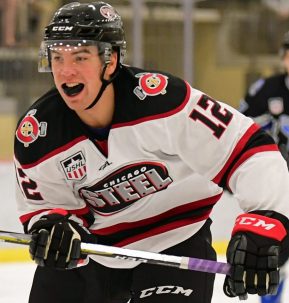
The Steel are led by one of the top drafted prospects in the league in Jack Dugan, a Vegas pick and one of the best non USNTDP draft prospects for this year in Blake McLaughlin. The two made up two-thirds of a great top line over the first half of the season, but were split up around mid-season after a coach firing reminiscent of what took place in Flint of the OHL last year. They also have a very promising 2019 prospect of their own in Robert Mastrosimone. Steel games have been high event games this year. Only the USNTDP has scored more and no other playoff team (including the ousted wild-card entrants) have surrendered more. That said, if they stick with Finnish import Oskar Autio in net, they have a very good chance of getting to the conference finals.
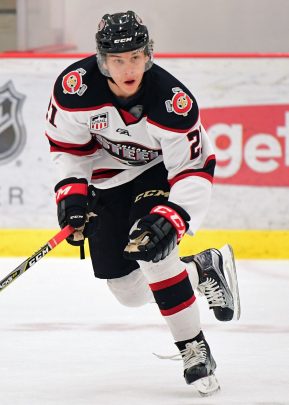
Draft eligible players to watch: For Chicago, pay attention to Blake McLaughlin. After exploding in the first half of the season, his production slowed measurably in the second half, but he scored twice in the wild card round. He is a dark horse pick in the late first round or early second round. For the US squad, Erik Middendorf is one of a select few who were not taken to Russia for the WU18 tournament. He is a decent two-way player who can skate. The Colorado College commit could be taken in the seventh round if he shows some offensive punch here.
Prediction: As they played Autio throughout the wild card round, I expect the status quo to remain for the best of five here. Chicago in five.
Youngstown Phantoms (2) vs Dubuque Fighting Saints (5)
Representing Exhibit A in why the Western Conference was the stronger one this year, both combatants here surrendered more goals than they scored this year, not something you would expect from a playoff team, much less the second seed from the East. Both teams have veteran rosters, with Dubuque bringing more size, although Youngstown plays a rougher game. The Phantoms somewhat make up for the time they spend in the penalty box by having a fairly strong penalty kill. Dubuque has been much more mediocre when it comes to special teams this year.
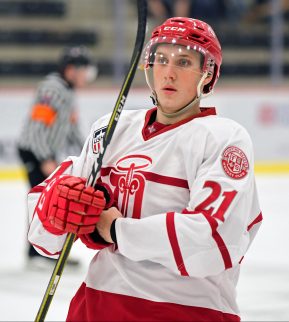
The Fighting Saints could have been much stronger this year, as their rosters includes three players drafted by NHL teams in Casey Staum (Mtl), Cole Guttman (TB) and Santeri Virtanen (Wpg). Unfortunately, injuries have meant that Dubuque has spent the majority of the season without any of the three and are not expected to have those players now either. Their offensive attack will be spearheaded by forwards Quinn Preston and Alex Steeves, the latter of whom is draft eligible. Joshua Maniscalco, a former USNTDP member, has been very productive from the blueline as well. Their goaltending looks to be a weakspot, despite Cole Weaver’s great work in shutting down Green Bay in the Wild Card round.
The Phantoms have more offensive weapons at their disposal, including Matthew Berry, Chase Gresock, and Michael Regush. They lack much offensive punch from their defensive corps, although midseason acquisition Michael Callahan has provided solid puck movement. The teams’ biggest strength, however comes from their stoppers. They likely expected to have Chicago draft pick Wouter Peeters claim the starters job this year – and he has been pretty good - but Russian import Ivan Prosvetov has been even better. No matter which netminder they choose for the playoffs, they will have a clear edge over Dubuque in the crease.
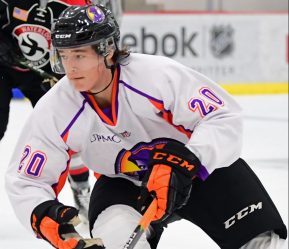
Draft eligible players to watch: From Dubuque, it can only be Alexander Steeves. The Notre Dame commit has a big engine and real offensive juice. The team’s leading scorer (seventh league-wide) always wants the puck on his stick and knows what to do when he gets it. From Youngstown, the pre-season pick would have been Curtis Hall, but he has shown that his lack of puck skill severely limits his upside. My personal favorite here is the goalie Prosvetov, who can absolutely dominate at his best. But he may not get the nod as Peeters is also very good. So I will pick Michael Callahan. He is not an exciting prospect, but the Providence commit does a lot of things quietly well.
Prediction: Youngstown in four. Between the top notch goaltending and the more diverse offensive attack, they will be tough to beat, especially under the assumption that Dubuque continues to play shorthanded.
Western Conference
Waterloo Black Hawks (1) vs Lincoln Stars (5)
The Waterloo-Lincoln series should be closer than the two teams’ relative place in the USHL standings would suggest. They both scored a hair under 200 goals on the season, although Waterloo has a team-level GAA of around 0.25 better. A factor that should play a role here is special teams play. Both teams are strong on the penalty kill, with Lincoln’s 84.7% kill rate coming second in the USHL. Waterloo, at 83.8% was not far behind. On the power play, however, the Black Hawks more than make up for the shortcoming when down a man. They had the league’s second best man advantage, scoring 23.6% of the time. Lincoln could only convert on 15.6% of their power plays.
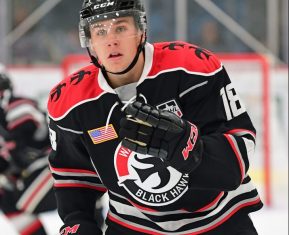 That Waterloo power play was a result of some strong offensive talent. Draft eligible Jack Drury is by far the league’s top power play producer with 12 goals and 22 assists coming on the man advantage. The team captain sees the ice well and knows how to take advantage of the extra space a power play brings. Speedy Ben Copeland, veteran Jackson Cates and midseason addition Benjamin Finkelstein (Fla) make them hard to stop.
That Waterloo power play was a result of some strong offensive talent. Draft eligible Jack Drury is by far the league’s top power play producer with 12 goals and 22 assists coming on the man advantage. The team captain sees the ice well and knows how to take advantage of the extra space a power play brings. Speedy Ben Copeland, veteran Jackson Cates and midseason addition Benjamin Finkelstein (Fla) make them hard to stop.
The goalie battle is also strong here. Both teams feature drafted goalies, on the roster with Matej Tomek (Phi) playing for Waterloo and Tomas Vomacka (Nsh) for Lincoln, but there is no guarantee that either of the latter get the nod. In the wild-card round, the Stars went with normal backup Derek Schaedig, after a rough outing in game one by Vomacka. The Black Hawks also have Jared Moe, one of the better draft eligible goalies in the league pushing Tomek for playing time.
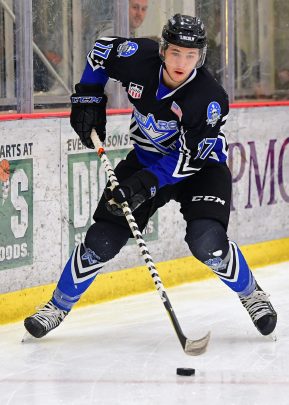
Draft Eligible Players to Watch: From Waterloo, pay attention to Drury. His offensive output has been fantastic and has the requisite hockey IQ expected from a legacy player (Son of Ted Drury) and Harvard commit. The question hanging over his prospect value is whether he can produce enough at even strength. From Lincoln, keep an eye on Paul Cotter, who scored the overtime winner in game 3 of the wild card round. He is a good skater with a nice shot and outstanding questions about his upside.
Prediction: Waterloo in four. Lincoln is the most penalized team in the league, with a gap of 129 minutes between them and the runners-up. That will really hurt them as the Black Hawks can take advantage, and will take advantage, over and over again, presuming Lincoln continues to play their brand of hockey.
Omaha Lancers (2) vs Fargo Force (3)
This series promises to be the exact inverse of the above-discussed matchup of Team USA and the Chicago Steel. While the other series should be full of end-to-end rushes, and blaring goal sirens, Omaha vs Fargo is a matchup of the two stingiest teams in the league. Fargo surrendered 133 goals on the season, while Omaha allowed only 143. Both teams enter hot, with Fargo having won five in a row and nine of ten, while Omaha is riding an eight game winning streak.
The goaltending on both sides is stellar. The expected starter for Omaha, Zach Driscoll, finished second in the league with a .934 save percentage. Fargo’s Strauss Mann came in third, at .932. Should, for any reason, either team need to turn to its backup, Fargo’s Ryan Bischel came in fifth in save percentage and Omaha’s Vincent Purpura finished eighth. Omaha’s offensive attack is led by undersized Czech veteran Filip Suchy, who came in second in league scoring with 69 points. Noah Cates (Phi) and Cole Gallant also both finished with over 50 points. Cates, in particular, is a talented player of the puck. Fargo only had one 50 point scoring in Grant Hebert, but Danish import Jacob Schmidt-Svejstrup would have also reached that plateau were it not for time missed for the WJC and a subsequent injury. Fargo also has a number of defensemen who can contribute to the attack, including Ty Farmer, Spencer Meir, and Robbie Stucker (Clb).
Both teams are good on the PK, sharing identical 83.5% kill rate. On the power play, we see some separation. Omaha was very good this year, scoring on 19% of their man up opportunities. Fargo, on the other hand, put everyone to shame, with a USHL high 24.5% power play success rate. Neither team is overly penalty prone, though, so this element may be diminished in significance during this series.
Draft Eligible Players to Watch: Fargo has an older roster on the whole, without any first time eligible players of note. That said, 20 year old Danish winger Schmidt-Svejstrup turned a lot of heads with his goal scoring exploits at the beginning of the season. He lacks pace and likes to fly the zone early, but he knows how to get himself into scoring position. He finished the season with 26 goals in 40 games. On Omaha, Ryan Savage had the most pre-season hype, but has been largely disappointing. Defenseman Travis Mitchell plays a muscular, disruptive style on the blueline, and could be a late round pick, but the real player to watch is left winger Jack Randl. The Michigan commit has promising offensive touch and will be relied upon in the second wave of attack for the Lancers.
Prediction: This is the closest matchup of the round. Omaha wins in five, thanks to better offensive depth. Lots of close, one goal (or two, with the latter being an empty netter) decisions.
Should the first round proper prediction play out, the Conference finals will pit Waterloo against Omaha in the West and Youngstown against Chicago in the East. In that scenario, I see Omaha shutting down Waterloo and Youngstown outscoring Chicago to set up a Clark Cup matchup between Omaha and Youngstown. In this battle of second seeds, Omaha proves the old adage that “defense wins championships” and brings home their eighth Clark Cup championship, and their first since 2007-08.































